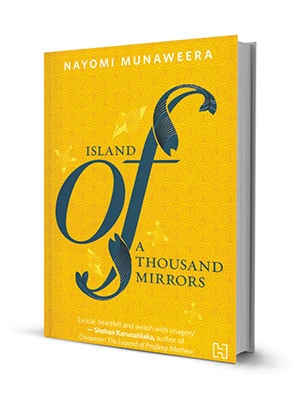
Book Review: Island of a Thousand Mirrors
Nayomi Munaweera’s debut novel is about nostalgia, fear and loss in Sri Lanka
Nayomi Munaweera’s debut novel attempts to transcend a little more than 60 years of history—the violent and strife-torn decades of post-colonial Sri Lanka—through three generations of two families.
What it fails to entirely achieve is historical perspective—not everyone is well acquainted with the origins and details of the Tamil-Sinhala conflict. But what it does achieve, and quite remarkably so, is an idyllic, near-perfect picture of the island, beaded together from the childhood nostalgia of generations.
The story begins in the childhood of the narrator’s parents—Nishan and Visaka. Woven into the story of the children’s lives are the politics of caste and social hierarchies and aspirations, parental ambitions, marital disappointments, teenage love and heartbreak, and the differences—those expressed politely by dignified and proud heads of families rather than those likely to set households ablaze—between Tamil and Sinhala people.
“When Sylvia Sunethra calls Buddhist monks to the house, their monotone chant is interrupted by the voice of a Tamil film heroine winding seductively down the stairs… Once a week the Shivalingam patriarch comes to grumble that his grandchildren cannot study because Sylvia Sunethra’s daughter is again playing her Western songs too loudly or that the smoke from Alice’s kitchen is rising into his windows.”
The idyllic quality of life—save one incident where Sinhala hoodlums board Nishan’s train to school in search of Tamil children to slaughter—is inherited by the narrator, Yashodhara, and her sister, Lanka. Rumblings of upheaval are too distant from their lives in Colombo.
But when violence steps across their threshold, it tears the family asunder; Nishan, Visaka and their children flee to the United States, where Visaka’s brother has set up home and business. The escalating violence and brutality in their homeland manifests itself on TV screens and radio, and in the waves of refugees flowing into the US. “Every year they come looking more and more shell-shocked. It is impossible to tell what they have seen, what they are escaping.”
While Nishan and Visaka struggle with finding jobs, homes and dignity, Yashodhara and Lanka morph from Sri Lankan children into American teenagers. And then into heartbroken adults. In their attempts to find themselves and their way back into their own lives, they head to Sri Lanka.
The narrative in Island of a Thousand Mirrors lingers in cavernous kitchens of childhood homes with the fragrance of comfort and love being stirred into pots, the taste of sambol and fish lingering on tongues, sand and sea salt like “frosting” on their skins. But, it also rushes past years at a time, abandoning characters that were nurtured and loved, to fates left to imagination.
The writing is brimming with vivid imagery: Lyrical and languid in its beauty, brutal and merciless in its violence. You are left with visions of a beautiful, tranquil island shredded with unspeakable terror and loss, but not quite knowing its cause.
Island of a Thousand Mirrors
Author: Nayomi Munaweera
Publisher: Hachette India
Price: Rs 399
Pages: 226
(This story appears in the 30 November, -0001 issue of Forbes India. To visit our Archives, click here.)






